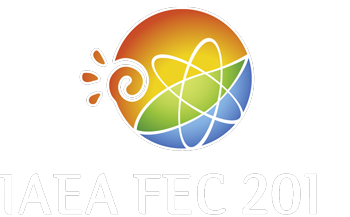Speaker
Dr
Zhiyong Qiu
(Zhejiang University)
Description
Theory of low-frequency zonal structure (LFZS) generation as one mechanism for Alfvén eigenmode (AE) nonlinear saturation is presented, including 1) spontaneous excitation of LFZS by beta-induced AE (BAE) via modulational instability, and 2) effects of energetic particles (EPs) on zonal flow (ZF) generation by Toroidal AE (TAE). It is found that, LFZS can be driven by a finite-amplitude BAE when the threshold condition due to frequency mismatch is exceeded, and the ZF growth rate depends on the BAE amplitude. Electrostatic ZF instead of zonal magnetic field is predominantly excited as the pump BAE is close to kinetic thermal ion induced shear Alfvén continuum gap. The excited ZF has both the usual meso-scale radial envelope structure, and a fine radial structure due to the BAE localization around mode rational surfaces. More significantly, the presence of the ZF fine structure significantly enhances the nonlinear couplings between ZF and BAE, leading to a much lower threshold condition on BAE amplitude. The obtained ZF radial electric field is an even function at the peak of radial envelope, consistent with numerical simulation. Effects of EPs on ZF generation by TAE have been investigated, showing that EP effects can qualitatively modify the process of ZF generation. It is found that nonlinear EP contribution in the ideal region dominates over the usual Reynolds and Maxwell stresses from thermal plasma contribution in the inertial layer. Due to the contribution of resonant EPs, ZF can be forced driven by TAE, with a growth rate being twice that of TAE. The ZF generation mechanism is shown to relate to EP quasilinear diffusion induced polarization. Similar to the BAE case, the driven ZF, has both the usual meso-scale radial envelope structure, as well as fine-scale structures due to the anti-Hermitian part of TAE mode structure associated with resonant EPs. This forced driven process is essentially thresholdless such that ZF can be generated in the linear growth stage of TAE, and may have important consequences on the nonlinear mode dynamics. A nonlinear model has been constructed to study TAE nonlinear saturation due to forced driven ZF, and different dynamics is observed in different parameter regimes.
| Country or International Organization | China |
|---|---|
| Paper Number | TH/P4-21 |
Author
Dr
Zhiyong Qiu
(Zhejiang University)
Co-authors
Fulvio Zonca
(Associazione EURATOM-ENEA sulla Fusione)
Prof.
Liu Chen
(Zhejiang University)

